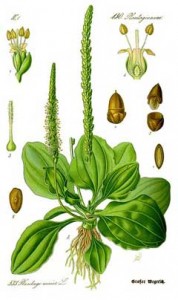It never ceases to amaze me how empowering it is to be able to walk into our backyard or local wooded area and find powerful medicinal plants available for their gift of healing.
North Carolina offers an abundant bouquet of healing plants. For the last three years I have been offering weekend workshops on identification,application and preparation of these magnificent plant allies. Some of the workshops most enjoyable moments come when the participents realize how our common local plants can have such a profound effect on our health. In the “Wise Woman” tradition the plants you need for healing are found right outside your door.
I would like to introduce you to one of my favorites. Plantain: Plantago major
To the uneducated eye this is another lawn and garden common weed most often dug up and disposed of in the compost heap. To the herbally enlightened it is a valued, potent friend.
Plantain followed us here from Europe, finding its way across America, following the white man’s footprint. One of its common names is “White Man’s Foot”. The most common ones to North Carolina are the broad leaf, narrow leaf and rattle snake plantain. Its habitat is wide and varied, found growing in lawns, neglected gardens, waste places (abandoned fields and edges of parking lots). Its uses were common knowledge before the industrial revolution.
With the resurgence of interest in herbal medicine, Plantain is taking its place again as a respected and valuable plant ally. I have used Plantain successfully many times with family and friends and have always been delighted and amazed at its gentle healing ways.
I was taught that Plantain used internally as a medicinal tea or tincture (alcohol extraction) was an excellent blood purifier; good for blood poisoning. Some say it’s as strong as penicillin for staph and strep infections. Topically it can be used as a poultice for poisonous insect bites, open festering wounds, to stop external bleeding, and to draw out splinters. A healing salve will speed the recovery of bruises and wounds.
It wasn’t until I started using the plant for myself that I witnessed
time after time its marvelous healing ways. Let me share a few with you.
A hazard of my ex-husband’s profession of carpentry, is the reoccurrence of puncture wounds. This particular time he developed a festering wound from a splinter he thought he had extracted. Within a few days a red line developed running up his arm. We collected a handful of Plantains’ fresh leaves and steeped this into a strong tea, soaking his hand in this solution for 30 min. three to four times a day. After 24 hours a large piece of wood emerged from his hand and within two to three days he was back hammer in hand.
A workshop favorite of mine is its use as a “spit poultice” (chew up a freshly picked leaf, and apply to infected area).This works beautifully on venomous insect bites by drawing out and neutralizing the venom.
I had the occasion to experience Plantains effect on insect bites one summer while collecting St. Johnswort in the North Carolina Mountains. I had foolishly gone off to collect herbs one day wearing a pair of sandals and somehow managed to step on a yellow jacket. It stung me in the tender skin between the toes. Ouch! I was far from camp and knew I had a long walk in front of me. Luckily I spied some plantain and made a “spit poultice”, wadding this on and around the bite. To my amazement, the bite never swelled or became inflamed. There was some slight itching but nothing much to speak of.
Traditionally it was used for venomous bites of snake, spider, and flying insects. Internally the tea can be used as a vermifuge (for worms).
The leaf tea taken two to three times a day is excellent for irritable bowel, stomach ulcers, and disorders of the Kidney and Urinary tract. The seeds are a good source of Physillium being mucilagenous and fibrous. The seeds are edible and good sprinkled fresh in a salad, or brewed in a tea. I’ve heard a tale that three teaspoons of fresh seeds eaten for three days makes one undesirable to mosquito bites (I’ve yet to witness this).
I have just started to discover the wonderful healing ways of this plant and look forward to discovering new ways to include it in my herbal healing journey.
Try plantain cooked as a pot herb (cook as you would any leafy green vegetable). A soothing medicinal tea can be made from 3 TBS. fresh herb/ 1 cup water. Steep anywhere from 15-40 minutes depending on the strength needed.
Description of Plantain for identification purposes:
Broad Leaf Plantain:
Look for smooth heavily ribbed broad leaves with flattened stems growing close to the ground in a basal rosette (from a central point growing out in a circle). Its leaves measure anywhere from 2 to 6 inches long. It flowers from late June through mid fall. Look for tiny flowers greenish to white in color growing along a leafless stem.
There are many medicinal plants growing right outside your door, for emergency situations how many can you discover?
News from Suki
Health Form
Greetings!
Welcome to Herb Haven! I am Suki Roth, founder and care-taker of Herb Haven, a vibrant teaching garden located in the Haw River Valley in Central North Carolina. The garden here is dedicated to the education, growth, and preservation of medicinal herbs. I am involved in the complete process of the production of our products. Together, with the community who supports our mission here, we plant, grow, harvest, create, and package herbal medicines.
I am a community practitioner, serving as educator, plant guide and herbal medicine consultant. I enjoy sharing my intuitive wisdom, knowledge of the plants and personal guidance with the wider community. I'm glad you've landed here on my website!
Blessings,
Suki
Herb Haven was in the News: CHECK IT OUT!


